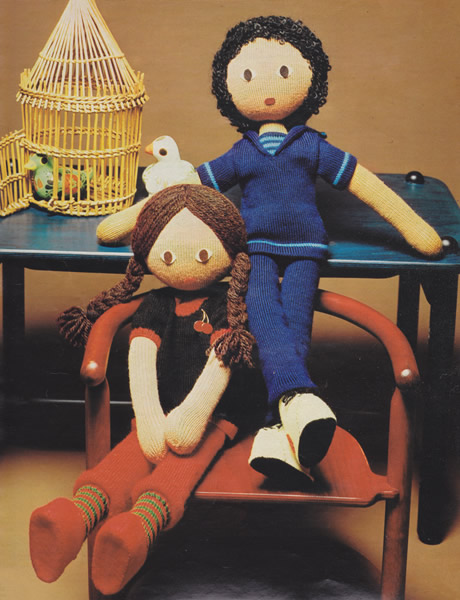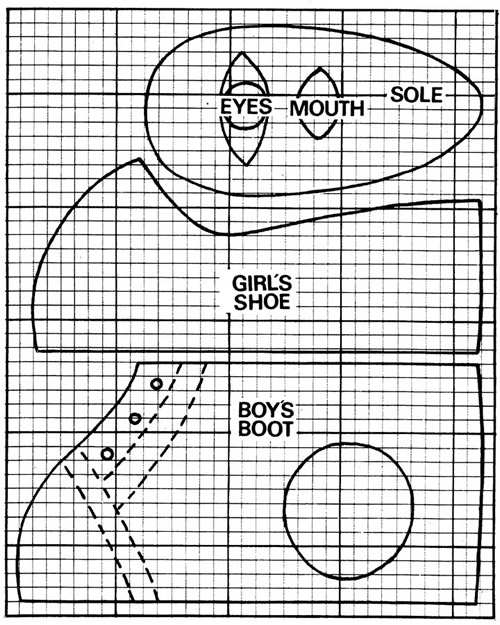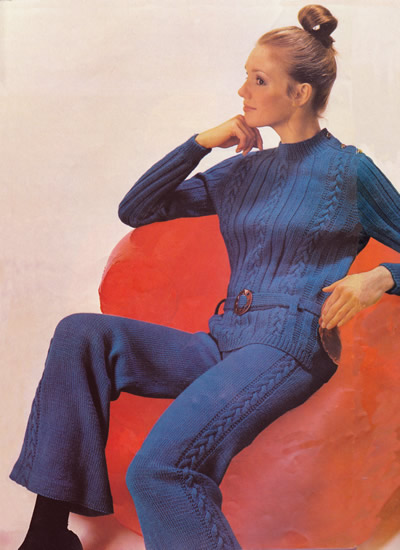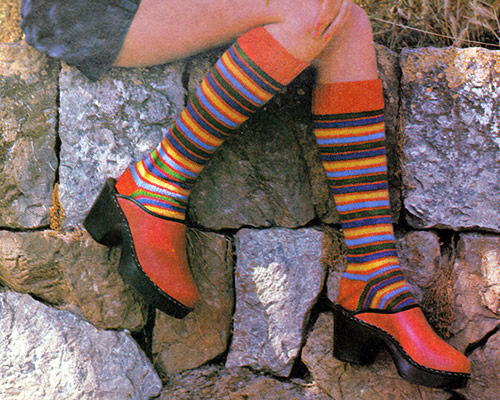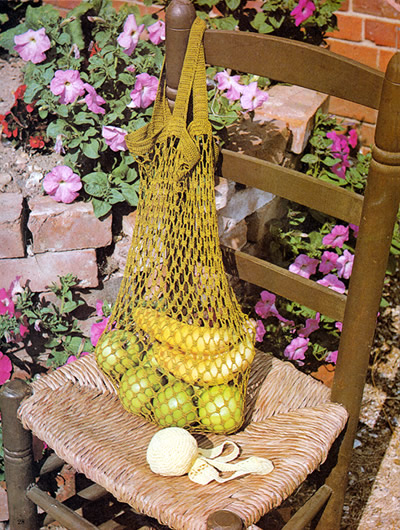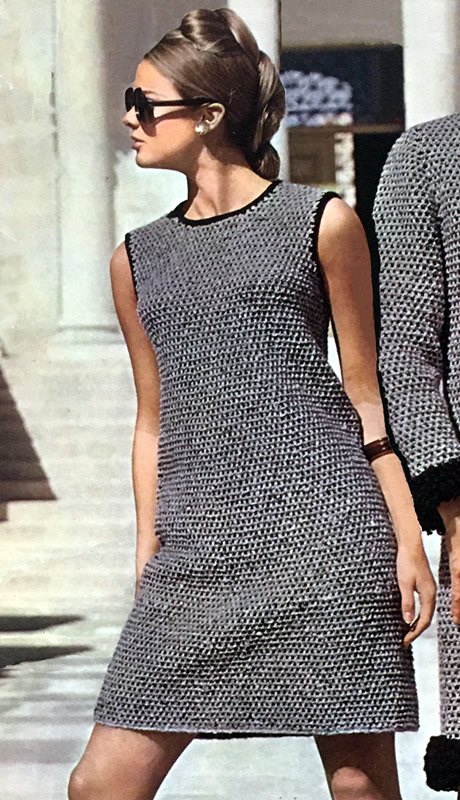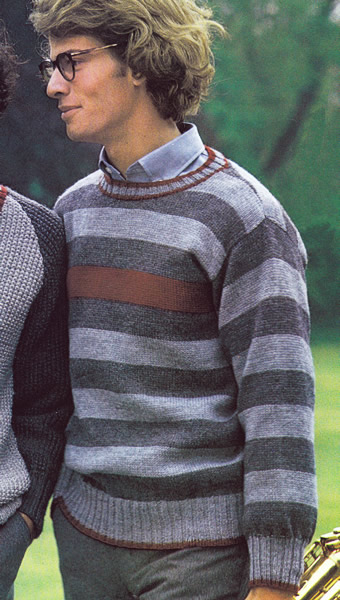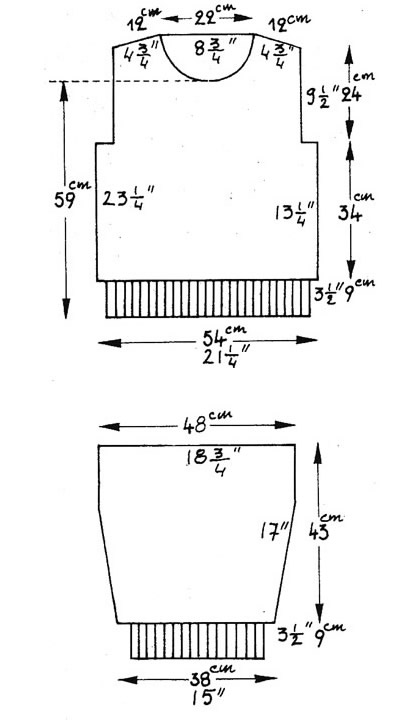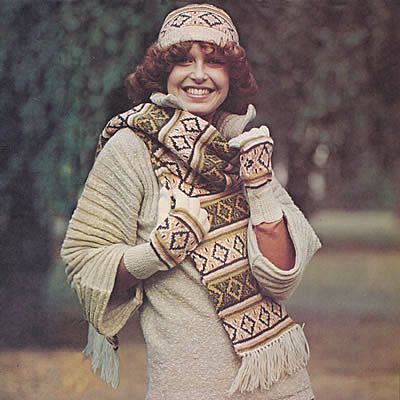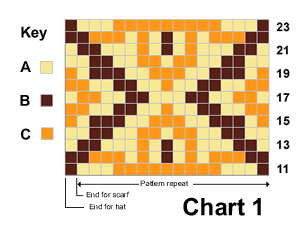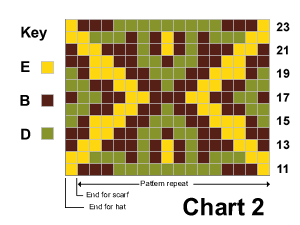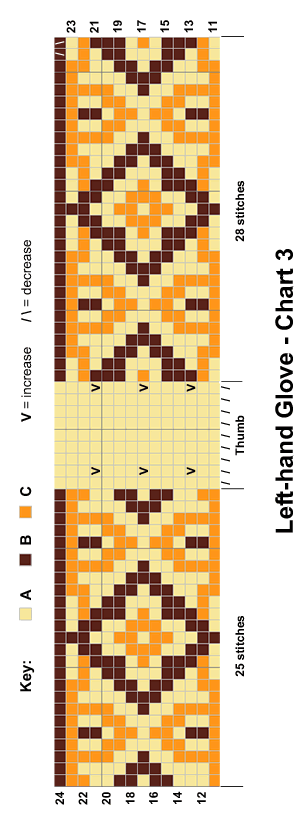Instructions.
3 sizes - larger sizes are given between brackets -
eg Small (Medium, Large).
Jumper Back
Using No 10 (3¼mm) needles, cast on 94 (106,
116) stitches and work 11 rows in k1/p1 rib.
Next row: Rib 7 (5, 10),
* work twice into the next stitch,
rib 7; repeat from * to last 7 (5, 10)
stitches; work twice into the next stitch, rib 6 (4, 9).
[105 (119, 129)
sts]
Change to No 8 (4mm) needles and pattern:
1st row (right side facing): k5 (4, 1);
[p4, k4] one (two, three)
times; * p2, k9, p2, [k4, p4] twice,
k4; repeat from * once, p2, k9, p2,
[k4, p4] one (two, three)
times, k5 (4, 1).
2nd row: p30 (37, 42);
* k4, p4, k4, p21; repeat from *
once, p9 (16, 21).
3rd row: k5 (4, 1);
[p4, k4] one (two, three)
times; * p2, sl3F, k3, k3 from cable
needle, k3, p2, [k4, p4] twice, k4, repeat from *
once, p2, sl3F, k3, k3 from cable needle, k3, p2, [k4, p4] one (two, three)
times; k5 (4, 1).
4th row: work as for 2nd row.
5th row: work as for 1st row.
6th row: work as for 2nd row.
7th row: k5 (4, 1);
[p4, k4] one (two, three)
times; * p2, k3, sl3B, k3, k3 from
cable needle, p2, [k4, p4] twice, k4, repeat from *
once, p2, k3, sl3B, k3, k3 from cable needle, p2, [k4, p4] one (two, three)
times; k5 (4, 1).
8th row: work as for 2nd row.
These 8 rows form the pattern. Continue in pattern until work measures
16 inches from the beginning, ending with a wrong side row.
Shape Armholes:
Keeping the continuity of the pattern, cast off 7 stitches at the beginning
of the next 2 rows. Decrease 1 stitch at each end of the next and every
following alternate row until 81 (89, 99)
stitches remain.
* Continue without further shaping
until work measures 7 (7½, 8)
inches from start of armhole shaping, ending with a right side row.
Shape Shoulders:
Next row (wrong side facing): cast
off 5 (6, 7)
stitches, pattern 20 (22, 25),
including the stitch used in casting off. Turn, leaving the remaining
stitches on a spare needle or stitch holder.
Next row: w2tog, pattern to end.
Next row: cast off 5 (6, 7)
stitches, pattern to last 2 stitches, w2tog. Repeat the last 2 rows once.
Work 1 row.
Cast off the remaining 6 (6, 7)
stitches.
With wrong side of work facing, join in yarn at the neck edge and work
to end.
Next row (wrong side facing): pattern
23 (26, 30)
stitches, w2tog.
Turn, leaving the centre 31 (33, 35)
stitches on a spare needle or stitch holder.
W2tog at the neck edge on the next 3 rows.
Next row: Cast off 5 (6, 7)
stitches, pattern to end.
Work 1 row.
Repeat the last 2 rows twice more.
Cast off the remaining 6 (6, 7)
stitches.
(The armhole is ½ inch shorter on the left side to allow for the
ribbing to make the shoulder opening).
Jumper Front
Follow instructions for Back from *
to *.
Continue without further shaping until work measures 4½ (5,
5½) inches from start of armhole shaping,
ending with a wrong side row.
Shape Neck:
Next row: Pattern 30 (33,
37) stitches and turn, leaving remaining
stitches on a spare needle.
Decrease 1 stitch at the neck edge on the next 9 rows.
Continue without further shaping until work measures 7 (7½,
8) inches from start of armhole shaping,
ending at armhole edge.
(The armhole is ½ inch shorter on the left side to allow for the
ribbing to make the shoulder opening).
Shape Shoulder:
Cast off 5 (6, 7)
stitches at the beginning of the next and 2 following alternate rows.
Work 1 row.
Cast off the remaining 6 (6, 7)
stitches.
Slip the centre 21 (23, 25)
stitches on to a spare needle.
Join in yarn at the neck edge to the remaining stitches, pattern to end.
Decrease 1 stitch at the neck edge on the next 9 rows.
Continue without further shaping until work measures 7½ (8,
8½) from the start of the armhole shaping,
ending at the armhole edge.
Shape Shoulder:
Cast off 5 (6, 7)
stitches at the beginning of the next and 2 following alternate rows.
Work 1 row.
Cast off the remaining 6 (6, 7)
stitches.
Jumper Sleeves
Using No 10 (3¼mm) needles, cast on 52 (54,
56) stitches and work 15 rows in k1/p1 rib.
Next row: Rib 5 (4,
7), *
work twice into next stitch, rib 5 (8,
13); repeat from *
to last 5 (5, 7)
stitches; work twice into next stitch, rib 4 (4,
6). [60 stitches].
Change to No 8 (4mm) needles and rib pattern.
1st row (right side facing): p4, *
k4, p4; repeat from * to end.
2nd row: k4, *
p4, k4, repeat from * to end.
These 2 rows form the pattern.
Increase and work into rib pattern, 1 stitch at each end of the 11th and
every following 12th (9th, 7th)
row until there are 76 (82, 88)
stitches on the needle.
Continue without further shaping until work measures 16½ (17,
17½) inches from the beginning, ending
with a wrong side row.
Shape Top:
Cast off 7 stitches at the beginning of the next 2 rows.
Decrease 1 stitch at each end of the next and every following 4th row
until 54 (58, 64)
stitches remain; then decrease 1 stitch at each end of every alternate
row until 36 (42, 46)
stitches remain.
Now decrease 1 stitch at each end of every row until 22 (24,
24) stitches remain.
Cast off.
Jumper Shoulder Edging
Using size 10 needles, cast on 11 stitches.
1st row (right side facing): k1, *
p1, k1, repeat from * to end.
2nd row: p1, *
k1, p1, repeat from * to end.
Repeat these 2 rows for ¾ inch.
1st Buttonhole row: Rib 4, cast off
3, rib to end.
2nd Buttonhole row: Rib to end, casting
on 3 stitches over cast off stitches in previous row.
Work 1¾ (2, 2¼)
inches in rib, measured from base of buttonhole.
Work another buttonhole.
Work ¾ (1, 1¼) inches in rib, measured from base of previous
buttonhole and ending with a wrong side row.
Leave these stitches on a safety pin.
Work a second piece to match, omitting buttonholes.
Jumper Neckband
Using a back stitch, join right shoulder seam.
With right side of work facing and using No 10 needles, rib across the
11 stitches of the Shoulder Edging with buttonholes; pick up and k13
stitches down left side of front neck; knit across the 21 (23,
25) stitches at centre front; pick up and
knit 15 stitches up right side of front neck; 7 stitches down right side
of back neck; knit across the 31
(33, 35)
stitches at the centre back, pick up and knit 4 stitches up left side
of back neck, then rib across the 11 stitches of the Shoulder Edging without
buttonholes. [113 (117, 121)
sts]
Next row (wrong side facing): p1,
* k1, p1, repeat from *
to end.
Next row: k1, *
p 1, k1 , repeat from * end.
Continue in rib, making a third buttonhole 1¾ (2,
2¼) inches from base of previous buttonhole.
Change to No 11 needles and work a further ½
inch in rib.
Cast off in rib.
Jumper Belt
Using No 10 needles, cast on 13 stitches.
1st row (right side facing): k1, *
p1, k1, repeat from * to end.
2nd row: p1, *
k1, p1, repeat from * to end.
Repeat these 2 rows for 36 (38, 40)
inches, ending with a wrong side row. Decrease 1 stitch at each end of
the next and every following
alternate row until 3 stitches remain.
Knit 3 together, and fasten off.
Belt Tabs (Make 4):
Using No 10 needles, cast on 7 stitches.
1st row (right side facing): k1, *
p1, k1, repeat from * to end.
2nd row: p 1, *
k 1, p 1, repeat from to end.
Repeat these 2 rows for 2 ½ inches, ending with a wrong side row.
Cast off in rib.
Making Up Jumper
Using a back stitch, join side and sleeve seams.
Stitch Shoulder Edgings to left shoulder with a flat stitch.
Sew in sleeves, overlapping Shoulder Edging.
Sew on buttons.
Stitch belt tabs into position as shown in photograph.
Sew buckle to straight edge of belt.
Slot belt through tabs.
|
Materials
Double Knitting yarn, 25g balls.
Jumper:
22 (24, 26)
One pair each of Nos 8 (4mm), 10 (3¼mm), and 11 (3mm) needles.
1 cable needle.
3 buttons.
1 buckle.
Trousers:
23 (25, 28)
One pair each of Nos 8 (4mm), and 10 (3¼mm) needles.
1 cable needle.
6 inch zip.
Elastic to fit waist.
1 trouser clip.
Tension
22 sts x 32 rows to 4 inches measured over stocking stitch
Size matters
Jumper: to fit chest 30-31, (34-35,
37-38)
actual measurement
32 (36, 39)
inches; length: 32 (36, 39)
inches; sleeve seam: 16½ (17, 17½)
inches.
Trousers: to fit hips 32-33 (35-36,
38-39) inches;
inside leg seam:
28 (28, 28)
inches.
Abbreviations:
k/p: knit/purl
w2tog: knit or purl 2 stitches together.
k2tog: knit 2 stitches together.
sl3F: slip the next 3 stitches on to a cable needle and leave
at front of work.
sl3B: slip the next 3 stitches on to a cable needle and leave at
back of work.
m1: make 1 stitch by picking up the strand of yarn before the next
stitch and knitting into the back of it.
sl1K: slip the next knitwise.
sl1P: slip the next purlwise.
A Word on the Wool
The original yarn was a standard double knitting, 100% superwash wool.
Disclaimer
(well...almost))
In transposing any pattern it is always a risk that errors will be introduced,
in spite of dedicated proof reading.
If you have any problems with this pattern, please
and I will try and assist.
|
Trousers Right Leg
Using No 8 (4mm) needles, cast on 121 (129,
137) stitches and work 9 rows stocking stitch,
(1 row knit, 1 row purl).
Next row (wrong side facing): Knit
to mark hemline.
Commence pattern:
1st row (right side facing): k53
(57, 61);
p2, k9, p2; k55 (59, 63).
2nd row: purl.
3rd row: k53 (57,
61); p2, sl3F, k3, k3 from cable needle,
k3, p2; k55 (59, 63).
4th row: purl.
5th row: as 1st row.
6th row: purl.
7th row: k53 (57,
61); p2, k3, sl3B, k3, k3 from cable needle,
p2; k55 (59, 63).
8th row: purl.
These 8 rows form the pattern.
Continue until 44 pattern rows in all have been worked.
Keep continuity of cable panel:
Next row: k2tog, work to last 2 stitches,
k2tog. [119 (127, 135)
sts]
Work 19 rows straight.
Next row: k2tog, work to end. [118
(126, 134)
sts]
Work 19 rows straight.
Repeat the last 40 rows once more. [115 (123,
131) sts]
Next row: k2tog, work to last 2 stitches,
k2tog. [113 (121, 129)
sts]
Work 19 rows straight.
Repeat the last 20 rows once more. [111 (119,
127) sts]
Next row: k2tog, work to end. [110
(118, 126)
sts]
Work 7 rows straight.
Next row: Work 60 (64,
68), m1, work to last stitch, increase into
last stitch. [112 (120, 128)
sts]
Work 5 rows straight.
Next row: Work to last stitch, increase
into last stitch. [113 (121, 129)
sts]
Work 1 row straight.
Next row: Work 60 (64,
68), m1, work to end. [114 (122,
130) sts]
Work 3 rows straight.
Next row: Work to last stitch, increase
into last stitch. [115 (123, 131)
sts]
Work 3 rows straight.
Next row: Work 60 (64,
68), m1, work to end. [116 (124,
132) sts]
Work 1 row straight.
Next row: Work to last stitch, increase
into last stitch. [117 (125, 133)
sts]
Work 5 rows straight.
Next row: Increase into first stitch,
work 44 (48, 52),
m1, work 15, m1, work to last stitch, increase into last stitch. [121
(129, 137)
sts]
Work 2 rows straight.
Next row: Work to last stitch, increase
into last stitch. [122 (130, 138)
sts]
Work 2 rows straight.
Next row: Increase into first stitch,
work to last stitch, increase into last stitch. [124 (132,
140) sts]
Work 1 row straight.
Next row: Work 64 (68,
72), m1, work to last stitch, increase into
last stitch. [126 (134, 142)
sts]
Next row: Work to last stitch, increase
into last stitch. [127 (135, 143)
sts]
Work 2 rows straight.
Next row: Increase into first stitch,
work to last stitch, increase into last stitch. [129 (137,
145) sts]
Work 1 row straight.
Next row: Cast off 3 stitches, work
to end. [126 (134, 142)
sts]
Next row: Cast off 16 stitches, work
to end. [110 (118, 126)
sts]
Next row: k2tog, work 61 (65,
69), m1, work to last 2 stitches, k2tog.
[109 (117, 125)
sts]
Work 1 row straight.
Next row: k2tog, work 45 (49,
53), m1, work to last 2 stitches, k2tog.
[108 (116, 124)
sts]
Work 1 row straight.
Next row: Work to last 2 stitches,
k2tog. [107 (115, 123)
sts]
Work 7 rows straight.
Next row: Work to last 2 stitches,
k2tog. [106 (114, 122)
sts]
Work 5 rows straight.
Next row: Work 45 (49,
53), k2tog, work to end. [105 (113,
121) sts]
Work 9 rows straight.
Next row: Work 61 (65,
69), m1, work to last 2 stitches, k2tog.
[105 (113, 121)
sts]
Work 7 rows straight.
Next row: Increase into first stitch,
work 43 (47, 51),
k2tog, work to end. [105 (113, 121)
sts]
Work 5 rows straight.
Next row: Work 22 (24,
26), [k2tog] twice, work 35 (37,
39), m1, work to last 2 stitches, k2tog.
[103 (111, 119)
sts]
Work 5 rows straight.
Next row: Work 77 (85,
93), [k2tog] twice, work to last 2 stitches,
k2tog. [100 (108, 116)
sts]
Work 1 row straight.
Next row: k2tog, work 19 (21,
23), [k2tog] twice, work 17 (19,
21), k2tog, work to end. [96 (104,
112) sts]
Work 3 rows straight.
Next row: Work to last 2 stitches,
k2tog. [95 (103, 111)
sts]
Work 3 rows straight.
Next row: k2tog, work 17 (19,
21), [k2tog] twice, work 15 (17,
19), k2tog, work 32 (34,
36), [k2tog] twice, work to end. [89 (97,
105) sts]
Work 1 row straight.
Next row: Work to last 2 stitches,
k2tog. [88 (96, 104)
sts]
Work 7 rows straight.
Next row: Work 67 (71,
75), [k2tog] twice, work to last 2 stitches,
k2tog. [85 (93, 101)
sts]
Next row (wrong side facing): Work
75 (82, 89)
stitches, turn, sl1K, work to end.
Next row: Work 65 (71,
77) stitches, turn, sl1K, work to end.
Next row: Work 55 (60,
65) stitches, turn, sl1K, work to end.
Next row: Work 44 (48,
52) stitches, turn, sl1K, work to end.
Next row: Work 33 (36,
39) stitches, turn, sl1K, work to end.
Next row: Work 22 (24,
26) stitches, turn, sl1K, work to end.
Next row: Work 11 (12,
13) stitches, turn, sl1K, work to end.
Next row: Work across all stitches.
Cast off.
Trousers Left Leg
Using No 8 (4mm) needles, cast on 121 (129,
137) stitches and work 9 rows stocking stitch,
(1 row knit, 1 row purl).
Next row (wrong side facing): Knit
to mark hemline.
Commence pattern:
1st row (right side facing): k55
(59, 63);
p2, k9, p2; k53 (57, 61).
2nd row: purl.
3rd row: k55 (59,
63); p2, sl3F, k3, k3 from cable needle,
k3, p2; k53 (57, 61).
4th row: purl.
5th row: as 1st row.
6th row: purl.
7th row: k55 (59,
63); p2, k3, sl3B, k3, k3 from cable needle,
p2; k53 (57, 61).
8th row: purl.
These 8 rows form the pattern.
Continue until 44 pattern rows in all have been worked.
Keep continuity of cable panel:
Next row: k2tog, work to last 2 stitches,
k2tog. [119 (127, 135)
sts]
Work 19 rows straight.
Next row: work to last 2 stitches,
k2tog. [118 (126, 134)
sts]
Work 19 rows straight.
Repeat the last 40 rows once more. [115 (123,
131) sts]
Next row: k2tog, work to last 2 stitches,
k2tog. [113 (121, 129)
sts]
Work 19 rows straight.
Repeat the last 20 rows once more. [111 (119,
127) sts]
Next row: Work to last 2 stitches,
k2tog. [110 (118, 126)
sts]
Work 7 rows straight.
Next row: Increase into first stitch,
work 49 (53, 57),
m1, work to end. [112 (120, 128)
sts]
Work 5 rows straight.
Next row: Increase into first stitch,
work to end. [113 (121, 129)
sts]
Work 1 row straight.
Next row: Work 53 (57,
61), m1, work to end. [114 (122,
130) sts]
Work 3 rows straight.
Next row: Increase into first stitch,
work to end. [115 (123, 131)
sts]
Work 3 rows straight.
Next row: Work 55 (59,
63), m1, work to end. [116 (124,
132) sts]
Work 1 row straight.
Next row: Increase into first stitch,
work to end. [117 (125, 133)
sts]
Work 5 rows straight.
Next row: Increase into first stitch,
work 56 (60, 64),
m1, work 15, m1, work to last stitch, increase into last stitch. [121
(129, 137)
sts]
Work 2 rows straight.
Next row: Increase into first stitch,
work to end. [122 (130, 138)
sts]
Work 2 rows straight.
Next row: Increase into first stitch,
work to last stitch, increase into last stitch. [124 (132,
140) sts]
Work 1 row straight.
Next row: Increase into first stitch,
work 59 (63,
67), m1, work to end. [126 (134,
142) sts]
Next row: Increase into first stitch,
work to end. [127 (135, 143)
sts]
Work 2 rows straight.
Next row: Increase into first stitch,
work to last stitch, increase into last stitch. [129 (137,
145) sts]
Next row: Cast off 3 stitches, work
to end. [126 (134, 142)
sts]
Next row: Cast off 16 stitches, work
to end. [110 (118, 126)
sts]
Work 1 row straight.
Next row: k2tog, work 45 (49,
53), m1, work to last 2 stitches, k2tog.
[109 (117, 125)
sts]
Work 1 row straight.
Next row: k2tog, work 45 (49,
53), m1, work to last 2 stitches, k2tog.
[108 (116, 124)
sts]
Work 1 row straight.
Next row: k2tog, work to end. [107
(115, 123)
sts]
Work 7 rows straight.
Next row: k2tog, work to end. [106
(114, 122)
sts]
Work 5 rows straight.
Next row: Work 59 (63,
67), k2tog, work to end. [105 (113,
121) sts]
Work 9 rows straight.
Next row: k2tog, work 42 (46,
50), m1, work to end. [105 (113,
121) sts]
Work 7 rows straight.
Next row: Work 59 (63,
67), k2tog, work to last stitch, increase
into last stitch. [105 (113, 121)
sts]
Work 5 rows straight.
Next row: k2tog, work 42 (46,
50), m1, work 35 (37,
39), [k2tog] twice, work to end. [103 (111,
119) sts]
Work 5 rows straight.
Next row: k2tog, work 20 (20,
20), [k2tog] twice, work to end. [100 (108,
116) sts]
Work 1 row straight.
Next row: Work 56 (60,
64), k2tog, work 17 (19,
21), [k2tog] twice, work to last 2 stitches,
k2tog. [96 (104, 112)
sts]
Work 3 rows straight.
Next row: k2tog, work to end. [95
(103, 111)
sts]
Work 3 rows straight.
Next row: Work 19 (21,
23), [k2tog] twice, work 32 (34,
36), k2tog, work 15 (17,
19), [k2tog] twice, work to last 2 stitches,
k2tog. [89 (97, 105)
sts]
Work 1 row straight.
Next row: k2tog, work to end. [88
(96, 104)
sts]
Work 7 rows straight.
Next row: k2tog, work 15 (19,
23), [k2tog] twice, work to end. [85 (93,
101) sts]
Work 1 row straight.
Next row (right side facing): Work
75 (82, 89)
stitches, turn, sl1P, work to end.
Next row: Work 65 (71,
77) stitches, turn, sl1P, work to end.
Next row: Work 55 (60,
65) stitches, turn, sl1P, work to end.
Next row: Work 44 (48,
52) stitches, turn, sl1P, work to end.
Next row: Work 33 (36,
39) stitches, turn, sl1P, work to end.
Next row: Work 22 (24,
26) stitches, turn, sl1P, work to end.
Next row: Work 11 (12,
13) stitches, turn, sl1P, work to end.
Next row: Work across all stitches.
Cast off.
Trousers Waistband
Using backstitch, join front and inside leg seams.
With right side of work facing, and using No 10 (3¼mm) needles pick
up and knit 160 (176, 192)
stitches evenly around waistband from centre back seam to centre back
seam.
Commencing with a purl row, work 8 rows in stocking stitch.
Next row: Knit (this row marks the fold line).
Commencing with a knit row, work a further 8 rows in stocking stitch.
Cast off fairly loosely.
Making Up Trousers
Sew in zip to centre back seam, placing top of zip in line with base
of waistband, then join
remainder of seam.
Turn waist and ankle hems onto wrong side and slip stitch down.
Thread elastic through waistband and secure at each end.
Sew trouser clip to waistband.
|







